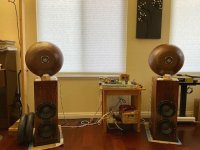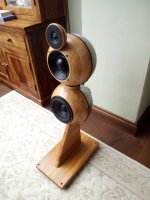There seems to be no evolutionary advantage of more than 2 ears, not a single animal has more. Snow owls catch the lemmings under a thick layer of snow guided by the grinding teeth noise.
A blind person creates clicks with the cane and perceives a 3-dimensional picture from surface reflections.
there is a reciprocity law so also only two speakers are needed to create a proper soundstage.
In fact when playing CDs a surround receiver mutes all speakers exept the main.
A blind person creates clicks with the cane and perceives a 3-dimensional picture from surface reflections.
there is a reciprocity law so also only two speakers are needed to create a proper soundstage.
In fact when playing CDs a surround receiver mutes all speakers exept the main.
It's only because our brain is desperately trying to make sense of the sound from two speakers that the stereo fudge works at all.
Those things that improve imaging (such as reducing VER) are also things that I find remove listening fatigue from my listening experience.It sounds like you are approaching reflections strictly from the perspective of imaging.
As a DIYer I can take the time to track down all reflections and manage or design around them. This is not a part of the process when someone buys a commercial speaker and places it in a room for a listening test.A room with abundant reflections is not likely to exhibit audible evidence of comb filtering from any single reflection.
The opening paragraphs of 7.1 in Toole's Third edition book (that you referred to be before) has added a few disclaimers and warnings due to misinterpretations of those research findings. Toole's book now aligns more closely with the quote from Geddes wesayso posted above.
Exactly right! People, please do read the 3rd edition, it is definitely NOT just a cosmetic update. There are MANY changes to the book.
And in fairness, it wasn't just misinterpretation. I think Toole's wording was a bit misleading on this particular issue (though I'm sure unintentionally so) in the previous editions of his book.
I may even go as far as guessing that he may have realised that he was a bit... how shall we put it?... plain wrong about early reflections, and then decided to gently walk back some of what he'd said, without overtly admitting that he was actually mistaken.
M.
Because it's been my long experience that because a study has reached a conclusion, that it's accepted as pretty much universal, and those that disagree are basically wrong.Is it so hard to discuss the research with an understanding that it is generally applicable and not universally applicable.
It's not like I designed my first speaker yesterday.
Yes, that has also been my experience.Those things that improve imaging (such as reducing VER) are also things that I find remove listening fatigue from my listening experience.
If so, then why bother about ER, VER or other room acoustics artifacts at all? 😛There seems to be no evolutionary advantage of more than 2 ears, not a single animal has more. Snow owls catch the lemmings under a thick layer of snow guided by the grinding teeth noise.
A blind person creates clicks with the cane and perceives a 3-dimensional picture from surface reflections.
there is a reciprocity law so also only two speakers are needed to create a proper soundstage.
But really, evolution outcome has nothing to do with reproducing a sound field in a room with boundaries. I do have two eyes. Are they enough to capture all of my surroundings all the time? Not really.
So when discussing acoustic artifacts troubling sound localization in rooms, don't leave out the elephant... the multichannel chapters are probably the least read pages of Toole's book. Of course it's compelling to discuss the merits of directivity, reflections and sound source localization. But since you're discussing a faint reproduction of the original sound field (what's that anyway?), the answer to the question what would be better by definition is a matter of taste in a lot of ways.
I don't get it.If so, then why bother about ER, VER or other room acoustics artifacts at all?

Well, if one states two speakers are enough, why bother about other sources contributing to the sound field?
The elephant in the room: there are room artifacts that don't belong to the original signal. The only right theoretical approach is to cancel them all. And listen in the free field. Everything else is a matter of taste. Now I am exaggerating, but we were nitpicking, weren't we?
The elephant in the room: there are room artifacts that don't belong to the original signal. The only right theoretical approach is to cancel them all. And listen in the free field. Everything else is a matter of taste. Now I am exaggerating, but we were nitpicking, weren't we?
Only if that's your goal for some reason. It isn't mine. Of course I do own headphones and find them less than satisfying - partly for that reason.The only right theoretical approach is to cancel them all.
...As to baffle width and imaging: I am of the opinion that they have to be really wide or very narrow to have good imaging.....
Regards
Charles
I completely agree, of all the speakers I have made - this speaker for me, has the very best imaging and is about as narrow as I could get. The tweeter is now waveguided too - to match mid/tweeter dispersion at crossover exactly.
Attachments
So you like the room to be in the acoustic equation. Perfectly OK. Do you agree that any discussion about small or wide baffles has to take the room properties into account? And do you agree that your and preference is a matter of taste, certainly when you’re leaving the room out? I guess then we can stop trying to convince each other.Only if that's your goal for some reason. It isn't mine. Of course I do own headphones and find them less than satisfying - partly for that reason.
Put otherwise: there is, apart from diffraction patterns caused by edges and the resulting comb filter effects, no single difference between small or wide baffles when in free field conditions.
I would disagree with about half of that, actually. There are certainly still differences outside. But I'm not currently doing Hi-Fi outside, so it doesn't matter much to me.
I completely agree, of all the speakers I have made - this speaker for me, has the very best imaging and is about as narrow as I could get. The tweeter is now waveguided too - to match mid/tweeter dispersion at crossover exactly.
Is that a volt mid dome? How does it compare to other mid domes?
Just to provide an example to support the idea that great imaging is not limited to speakers with narrow baffles.

Fostex FF85wk's in spheres running from 200Hz up. The imaging is impressive.
By the way, I feel that the arguments regarding whether narrow speakers image better are not that relevant in the debate of whether a narrow baffle is inferior to a wide baffle.

Fostex FF85wk's in spheres running from 200Hz up. The imaging is impressive.
By the way, I feel that the arguments regarding whether narrow speakers image better are not that relevant in the debate of whether a narrow baffle is inferior to a wide baffle.
Last edited:
You can get good imaging with narrow baffles, wide baffles and anything in between 😀.
It all depends on execution, which also means that narrow baffled speakers don't have to be flawed.
It all depends on execution, which also means that narrow baffled speakers don't have to be flawed.
KCHANG ... I wouldn't consider that tweeter hemispheric baffle "small". What is more interesting is how the shape works to launch enough energy toward its mate to build the image. This is the quality that true constant directivity speakers lack.
The opening paragraphs of 7.1 in Toole's Third edition book (that you referred to be before) has added a few disclaimers and warnings due to misinterpretations of those research findings. Toole's book now aligns more closely with the quote from Geddes wesayso posted above.
If you look through all the research on blind listening studies the greatest confounding factor is always the program material that was used to conduct the test. So while the results are valid for the music that was used to conduct them it is not always completely transferrable to other types of program material and goes a long way to understand why the results can be valid but other people still come to their own different conclusions based on what they listened to.
A few years ago I couldn't care less about imaging and often found it to be distracting and annoying. In my most recent system I have reduced the early reflections significantly and changed the positioning of the speakers. I can now hear some very precise positioning within and beyond the bounds of the speakers and I must say that I have been converted to the point that I listen to some tracks just because of the amazing imaging. I can now see why some people are so fanatical about it.
Toole included the impact of program material in his 3rd edition. I think it's good for people to read the chapter 7 sections and take a close look at the images he includes. I circled one of the dots in red to make sure people understand I'm not conflating generalization with universal truth. Especially since this is research on preferences. Yes, we're going to have outliers and those people will really like imaging.
also, this,
"I listen to some tracks just because of the amazing imaging." - Fluid
makes sense. Music style + recording quality.
On the other hand, Geddes points out that it's a compromise in other areas.
"It appears now that he and I both agree that Very Early Reflections (VER) are a compromise. While they add spaciousness, envelopment and enhance ASW, they will degrade imaging on more dry studio type recordings." - Geddes post #510
Our tastes can change with time and education, or even a desire to hear something new. I think that's good as long as it doesn't lead to burn out. I think Geddes did something smart. He decided he liked something and was satisfied. He's obviously aware of the compromises but he's happy with his system.
Attachments
- Home
- Loudspeakers
- Multi-Way
- Are modern narrow baffle designs inherently flawed?


